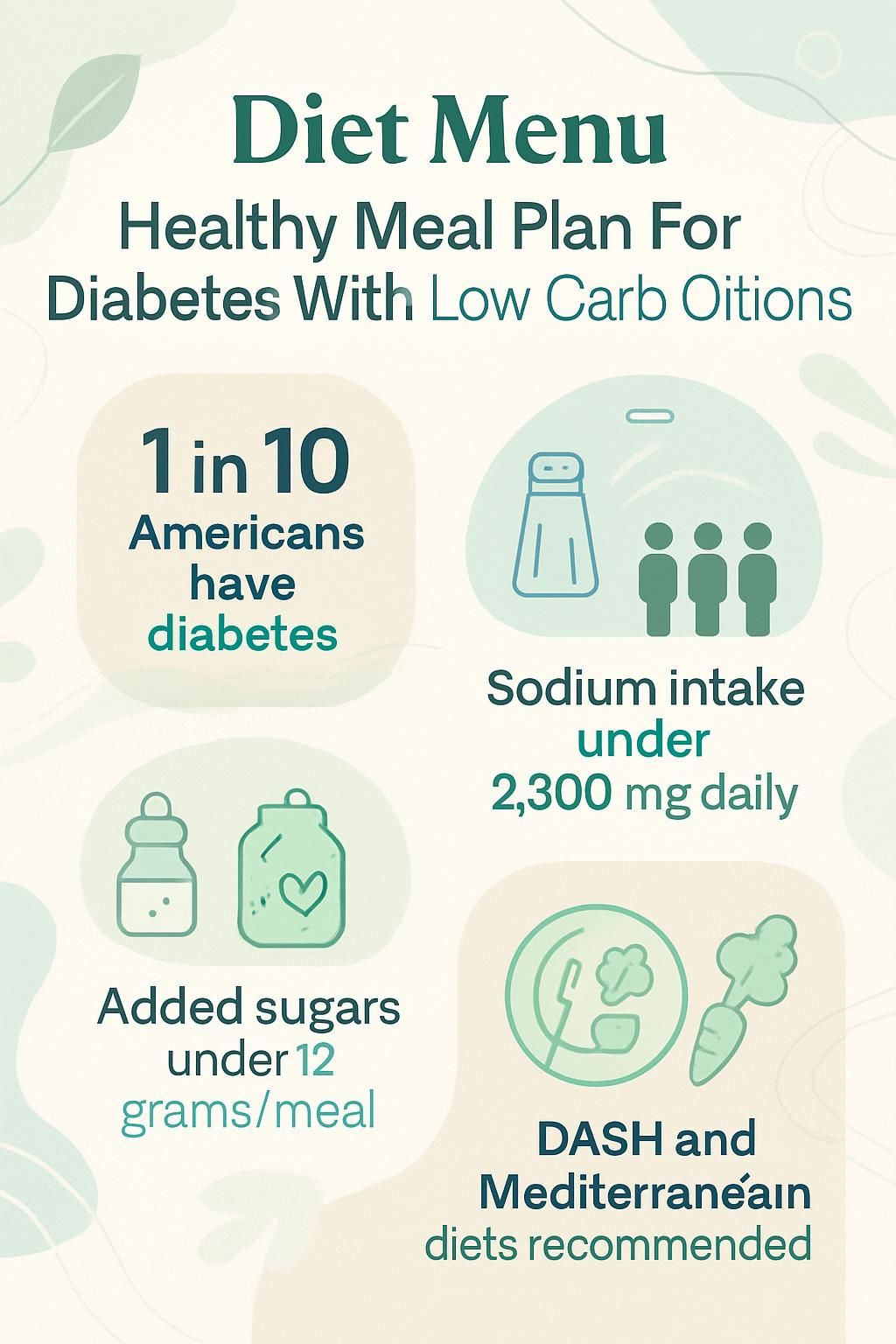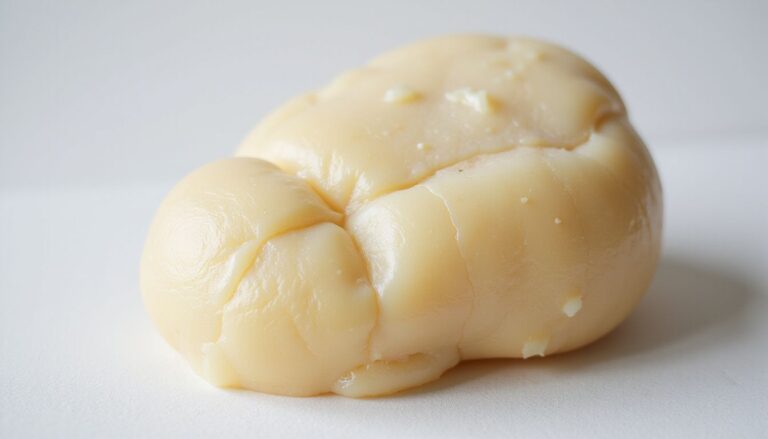Diet Menu: Healthy Meal Plan For Diabetes With Low Carb Options
Our Nutrition Assistant AI Suite will transform your body. You will lose fat, get toned, and build muscle. Gain confidence and optimal health.
Managing blood sugar can feel confusing at first. A clear low-carb meal plan makes daily choices easier and helps you stay on track. You will see practical steps to build healthy meals, set portions, and keep flavor without extra sugar or salt.
Inside, you will find sample menus, simple swaps for breakfast and dinner, and smart ways to add more vegetables. Tips focus on budget-friendly options, steady energy, and real-life routines. Small changes today can improve your health in lasting ways.
Key Takeaways
- About 1 in 10 Americans has diabetes. Aim for less than 2,300 mg of sodium per day and keep added sugars under about 12 grams per meal.
- Low-carb patterns such as DASH or Mediterranean support blood sugar control and heart health, according to the American Diabetes Association (2024).
- Build meals around non-starchy vegetables, lean protein like salmon or turkey, olive oil, nuts, and whole grains.
- Portion control with measuring cups or a food scale helps keep glucose steady. Meal planning apps like MyPlate can set daily calorie ranges from 1,200 to 2,000.
- Skip high-sugar drinks and candy. Choose water, unsweetened tea, or coffee without sugar for better blood sugar control.

How Does Diet Affect Diabetes Management?

Food choices affect blood sugar at every meal. The mix of carbohydrate, protein, and fat changes how fast sugar enters your bloodstream. Balanced plates, planned ahead, support stable energy and long-term health.
Why is controlling blood sugar important?
Keeping blood sugar in range helps protect nerves, blood vessels, eyes, and kidneys. High levels over time raise the risk for heart disease and stroke. Managing carbs and using a steady meal plan lowers those risks.
Limiting sodium to less than 2,300 mg per day reduces strain on the heart and kidneys. Research shows better glucose control links to fewer complications, including coronary artery disease. I switched from refined-grain sandwiches to salads with lean protein at lunch, and my afternoon energy no longer dipped.
Managing your diet is one of the most powerful tools you have for controlling diabetes.
How can a low-carb diet benefit people with diabetes?
Lowering carbs smooths post-meal spikes. Cutting refined grains and added sugars slows digestion, so blood sugar rises less and falls more gently. A sample day under 2,000 calories with 44 grams of total carbs can support both glucose and weight control.
Fiber helps too. Aim for up to 30 grams per day from whole grains, beans, vegetables, and modest fruit. This slows how fast sugar moves into the blood. Low-carb plans often improve cholesterol and blood pressure, both key heart risk factors.
Build meals with lean protein, healthy fats like avocado or almonds, and high-fiber sides. This balance can increase fullness and reduce cravings between meals.
Key Principles of a Diabetes-Friendly Meal Plan
Healthy eating patterns help you manage blood sugar and reach weight or blood pressure goals. Start with nutrient-dense foods, then shape portions to fit your needs.
What nutrient-dense foods should I focus on?
Load your plate with non-starchy vegetables such as leafy greens, broccoli, bell peppers, and cauliflower. They add vitamins, minerals, and fiber with very few carbs.
- Choose whole grains, for example quinoa or brown rice, for B vitamins and magnesium.
- Pick fruits rich in antioxidants like berries or oranges, keeping portions moderate.
- Use fat-free or low-fat dairy such as skim milk or nonfat yogurt for calcium and protein.
- Lean protein choices include skinless poultry, fish high in omega-3s like salmon, beans, and tofu.
- Nuts and seeds add healthy fats and crunch with minimal carbs.
High-fiber foods support steady energy. I often swap roasted sweet potato for regular potato at dinner to avoid a quick blood sugar rise.
Why limit refined carbs and added sugars?
Refined carbs and added sugars trigger fast spikes, then energy crashes. White bread, regular pasta, pastries, and sugary drinks lack fiber and key nutrients. Over time, these foods raise cardiovascular risk.
Keeping added sugars to about 10 to 12 grams per meal can help. Replacing mayonnaise with hummus on a sandwich is one easy way to cut added sugar and saturated fat.
How to balance healthy fats, protein, and fiber?
Limit refined carbs, then build balance. Healthy fats such as olive oil and almonds help you feel full and support heart health. Lean proteins like salmon, chicken, or tuna stabilize blood sugar when paired with fiber-rich sides.
In one sample day, the plan includes about 57 grams of healthy fats, 86 grams of protein, and 31 grams of fiber. This mix slows carbohydrate absorption and can reduce hunger. Balanced meals also help with weight management and blood pressure control.
Low-Carb Diet Options for Diabetes
Many eating patterns can be low in carbs and still flexible. Pick the option that fits your taste, budget, and culture, then adjust portions to meet your goals.
What is the Mediterranean diet?
The Mediterranean diet focuses on vegetables, fruit, whole grains such as couscous, beans, nuts, olive oil, fish, and poultry. It limits red meat and highly processed foods. The plan is rich in antioxidants and fiber, and it highlights monounsaturated fats, which can help lower LDL, the less healthy cholesterol.
Research from 2017 to 2024 links this pattern to better blood sugar control and heart health. It is easy to customize and works well for plant-forward meals.
How does the DASH diet support diabetes?
DASH lowers sodium to less than 2,300 mg per day and promotes nutrient-dense foods. It includes vegetables, fruits, whole grains, beans, nuts, low-fat dairy, fish, and poultry. It limits fatty meats, full-fat dairy, sweets, and sugary drinks.
A sample DASH day can provide about 1,727 calories, 58 grams of fat with only 14 grams saturated fat, around 87 grams of protein, about 30 grams of fiber, 12 grams of added sugars, and roughly 1,157 mg sodium. These targets support steady energy and blood sugar. Cooking with these guidelines made portion planning much simpler for me.
When is the ketogenic diet appropriate for diabetes?
The ketogenic diet is very low in carbs and high in fat. Some studies show it can lower A1C, the three-month average of blood sugar, and support weight loss. It is not right for everyone.
Speak with your healthcare provider or a registered dietitian first, especially if you use insulin or diabetes medications. Cutting carbs too quickly can cause low blood sugar. Medical oversight helps you set safe targets and avoid nutrient gaps.
Essential Components of a Low-Carb Meal Plan
A smart low-carb plan focuses on whole foods, clear portions, and a simple formula: non-starchy vegetables, lean protein, and healthy fats.
Which non-starchy vegetables are best?
Great picks include spinach, broccoli, green beans, carrots, and summer squash. These add volume and color without many carbs.
- Spinach, 3 cups raw, makes a fiber-rich salad base.
- Broccoli, 1 cup steamed, provides vitamins C and K with roughly 6 grams of carbs.
- Green beans, 3/4 cup, pair well with grilled protein.
- Carrots, about 10 baby carrots, add crunch as a snack or side.
- Summer squash, 1 cup, works as a light pasta swap.
Try a half cup each of onion, bell pepper, mushrooms, broccoli, and carrots in a quick stir-fry. It is a fast way to fill your plate and limit refined grains.
What are good lean protein choices?
Lean proteins help steady blood sugar and support muscle. Rotate sources to keep meals interesting.
- Fish such as salmon or flounder, about 4 ounces, offer protein and heart-friendly fats.
- Skinless chicken breast or low-sodium tuna, about 3 ounces, are classic low-carb options.
- Plant choices like a veggie burger or a few falafel patties reduce saturated fat.
- Roast chicken and steamed shrimp are easy, low-sugar, and low-fat staples.
- For a quick lunch, fill a mini whole wheat pita with 3 ounces of turkey.
Leftover grilled fish on a salad is my weekday go-to. It saves time and keeps carbs in check.
Which healthy fats should I include?
Choose fats that support heart health and fullness without raising blood sugar.
- Olive oil, about 1 tablespoon on salads or vegetables.
- Avocado, half to one small fruit on toast, salads, or tacos.
- Nuts, about 1/4 cup almonds, for a filling snack.
- Nut butter, 2 tablespoons on whole grain toast at breakfast.
Keep saturated fat modest. Sample days range from about 10 to 14 grams. Use small amounts of cashews or seeds to finish a stir-fry.
Why choose whole, unprocessed foods?
Whole foods contain more fiber and micronutrients than processed options. They help control blood sugar and reduce hidden sugars and sodium.
- Try brown rice, wild rice blends, or whole-wheat pasta for steady energy.
- Pick whole fruit, such as an orange, instead of fruit juice to reduce rapid sugar intake.
- Swap white bread for whole-wheat toast or a whole-grain bagel.
Tools like MyPlate can help you plan simple meals on a budget with fewer packaged snacks.
A 7-Day Sample Low-Carb Meal Plan for Diabetes
Use these ideas as a starting point. Adjust servings, swap ingredients you enjoy, and match your calorie needs with advice from your care team.
What to eat for breakfast, lunch, and dinner on Day 1?
Breakfast: 3/4 cup bran flakes with 1 banana and 1 cup fat-free milk. This provides fiber and steady fuel.
Lunch: Mini whole-wheat pita filled with 3 ounces turkey, half a roasted pepper, 1 teaspoon mayonnaise, mustard, and lettuce. Add one mozzarella string cheese and two kiwis. A veggie Niçoise pita is another option at about 290 calories.
Dinner: Four ounces flounder, 1 cup cooked couscous, and 1 cup steamed broccoli. Finish with a single-serve ice cream to satisfy a sweet craving without a big spike.
What to eat for breakfast, lunch, and dinner on Day 2?
Breakfast: 1 cup mixed fruit and half a whole-wheat bagel with 1 tablespoon peanut butter. Add 1 cup skim milk for protein and calcium.
Lunch: Vegetable soup with a veggie burger on whole grain toast or an English muffin. Include 1 cup grapes for extra antioxidants.
Dinner: Barbecue cutlets at about 265 calories per serving with citrus slaw or sautéed spinach cooked in olive oil and garlic. Add half a baked potato for balance. A mushroom-quinoa burger also fits low-carb goals.
What to eat for breakfast, lunch, and dinner on Day 3?
Breakfast: 1/2 cup oats cooked in unsweetened soy or low-fat milk. Top with half a sliced apple, 1 teaspoon honey, and cinnamon.
Lunch: Chicken salad with 4 ounces roast chicken, 1/4 cup grapes, 1 tablespoon almonds, 1/4 cup celery, plus 1 tablespoon mayonnaise mixed with 1 tablespoon Greek yogurt. Serve over lettuce with multigrain toast.
Dinner: Four ounces steamed shrimp, a baked potato topped with 3 tablespoons salsa and 1 tablespoon Greek yogurt, and 3 cups sautéed spinach. End with 1 ounce chocolate or a 100 to 150 calorie ice cream bar.
What to eat for breakfast, lunch, and dinner on Day 4?
Breakfast: 1 cup plain or low-sugar Greek yogurt with 1 cup fresh berries for fiber and antioxidants.
Lunch: 1 cup tomato soup and a mini whole-wheat pita stuffed with 3 ounces roast beef, 1 teaspoon horseradish, mustard, tomato, and lettuce. Add 2 cups raw vegetables with 1/4 cup hummus.
Dinner: Four ounces poached salmon with slaw made from 1.25 cups coleslaw mix, two sliced scallions, 1 tablespoon rice vinegar, and 1.5 teaspoons olive oil. Include 1 cup cooked quinoa for complex carbs. Meals like this kept my afternoon energy steady.
What to eat for breakfast, lunch, and dinner on Day 5?
Breakfast: 1 cup Cheerios, 1/2 cup berries, and 1 tablespoon almonds with 6 ounces plain unsweetened Greek yogurt.
Lunch: Mushroom quesadillas, ready in about 25 minutes, plus cucumber spears. Add 1/2 cup cottage cheese or extra Greek yogurt and two clementines.
Dinner: Pork tenderloin with balsamic, honey, and thyme sauce at about 370 calories per serving. Add roasted butternut squash for fiber and a lower-carb side.
What to eat for breakfast, lunch, and dinner on Day 6?
Breakfast: Whole-grain waffle with 2 tablespoons nut butter and 1 sliced banana. Sprinkle cinnamon and nutmeg. Drink 8 ounces fat-free milk.
Lunch: Tuna salad mixed with low-fat mayonnaise and nonfat yogurt, about 135 calories per serving. Add 10 baby carrots, two-thirds cup Greek yogurt, and 1 fresh pear.
Dinner: Spicy sausage jambalaya with 3 cups spinach sautéed in 1 tablespoon olive oil and garlic. This pairing adds iron, protein, and antioxidants.
What to eat for breakfast, lunch, and dinner on Day 7?
Breakfast: Half an English muffin topped with 1 ounce reduced-fat cheese, tomato slices, and 1 cup sautéed spinach. Add one poached egg and a grapefruit.
Lunch: Black bean salad with 1/2 cup black beans and orange slices plus red pepper, onion, scallions, and extra raw veggies. Dress with 1 teaspoon vinegar. Serve on leafy greens with one corn tortilla and a piece of fruit. This keeps me full through busy afternoons.
Dinner: Grilled chicken or fish with roasted broccoli or cauliflower. Add quinoa or brown rice if you want more fiber.
Tips for Planning Low-Carb Meals
Planning ahead reduces stress at mealtime. A few simple tools and habits can make low-carb cooking fast and repeatable.
How can portion control help in meal planning?
Portion control helps manage calories and blood sugar. Plans between 1,200 and 2,000 calories per day are common, with steps up such as 1,300, 1,400, 1,500, or 1,800.
- Use measuring cups or a food scale for proteins, grains, and snacks.
- Plate non-starchy vegetables first to fill half your plate.
- Keep carb servings modest, then add protein and healthy fats.
I started weighing portions at home after seeing how large restaurant servings are. Energy felt steadier once I matched portions to my goals.
How to use herbs and spices to add flavor?
Herbs and spices add flavor without carbs. They also help you cut back on sugar and salt.
- Use garlic and olive oil to sauté spinach or make a quick stir-fry.
- Brighten slaw with 1 tablespoon rice vinegar and 1.5 teaspoons olive oil.
- Season oats with cinnamon and nutmeg, then use a small drizzle of honey if needed.
- Finish meals with fresh basil, parsley, or cilantro.
What are effective ways to plan meals ahead?
Try MyPlate Kitchen for recipe ideas, videos, and saved cookbooks. The Start Simple with MyPlate app can help you track meals and habits. The MyPlate Plan calculator gives suggestions based on age, activity, and body size.
- Batch cook lean proteins and vegetables on one day.
- Portion into reusable containers for easy lunches and dinners.
- Make a grocery list right after choosing recipes to avoid impulse buys.
Snacks and Beverages for a Low-Carb Diabetes Diet
Smart snacks and drinks can prevent big swings in blood sugar. Pick simple items you enjoy so the habit sticks.
What are healthy low-carb snack options?
Mix protein, fiber, and healthy fat for steady energy between meals.
- 1 cup low-fat yogurt with 1 sliced peach.
- 1/4 cup unsalted trail mix with nuts and seeds.
- 1/4 cup almonds with a fresh peach.
- Two kiwis with one mozzarella string cheese.
These snacks add nutrients without large carb loads. They also help curb cravings later in the day.
Which low-carb drinks are best for diabetes?
Water is the top choice. It has no carbs or calories and supports hydration. Unsweetened tea and black coffee also work well. Fat-free or skim milk provides protein and calcium, while unsweetened soy milk keeps added sugars low.
I swapped sugary soda for plain sparkling water. My glucose readings stayed closer to target.
| Drink Type | Typical Serving Size | Average Carbs per Serving |
|---|---|---|
| Water | 8 oz | 0 g |
| Unsweetened Tea | 8 oz | 0 g |
| Black Coffee | 8 oz | 0 g |
| Fat-Free or Skim Milk | 1 cup | 12 g |
| Unsweetened Soy Milk | 1 cup | < 3 g |
Choosing low-carb drinks lowers daily carb totals compared with soda, juice, or energy drinks, which often contain 20 to 30 grams or more in one serving. See the American Diabetes Association Standards of Care, 2024, for beverage guidance.
Foods to Avoid or Limit
Some foods quickly raise blood sugar or add excess sodium and saturated fat. Limiting them supports steady numbers and heart health.
Which high-sugar foods and drinks should I avoid?
Skip soda, fruit punch, energy drinks, sweetened teas, and flavored lattes. Many contain over 30 grams of added sugar per serving.
- Candy bars, pastries, regular ice cream, donuts, cakes, cookies, and syrupy pancakes.
- Many cereals and granola bars with hidden sugars.
- Low-fat or fat-free items that replace fat with sugar.
Check labels and aim for no more than about 10 to 12 grams of added sugar per meal. Choose fresh berries or a small low-sugar yogurt for dessert instead.
Why limit refined grains and processed snacks?
Refined grains such as white bread and regular pasta are low in fiber and can spike blood sugar. Processed snacks often add sugars and unhealthy fats that make diabetes harder to manage.
Whole grains like brown rice or whole-wheat pasta improve blood sugar control and provide more nutrients. Cutting back on sugary snacks can also reduce cravings later in the day.
Benefits of Following a Low-Carb Meal Plan
Lower-carb eating helps with glucose control, heart protection, and sustainable weight loss. The benefits build over weeks and months.
How does a low-carb diet improve blood sugar control?
Reducing carbs limits how much glucose enters your blood after meals. Insulin can work more effectively, which lowers spikes. A sample day with 44 grams of total carbs and only 10 grams of added sugars shows how this can look in practice.
Fiber from produce and legumes, plus lean protein, supports safe and steady numbers. A plan near 30 grams of fiber per day adds extra help.
Can it reduce the risk of diabetes complications?
Better blood sugar control reduces the risk of nerve, kidney, and eye damage. Keeping sodium under 2,300 mg per day helps lower blood pressure, a common issue in diabetes. The DASH pattern also keeps saturated fat modest, which supports heart health.
Whole foods and fewer refined carbs can improve cholesterol levels and reduce heart and stroke risk over time.
How does it support sustainable weight management?
Structured plans, such as a 1,200-calorie day adjusted to your needs, encourage steady weight loss. Flexibility prevents feelings of deprivation and makes healthy habits easier to maintain.
I found that whole foods and low-carb meals helped with hunger control across the day. Many people do well when they mix portion control with protein, healthy fats, and fiber.
Working with a Dietitian or Healthcare Provider
Partnering with a professional gives you a plan that fits your medical needs, culture, schedule, and budget. It also keeps your approach safe if you use medications.
How to tailor a meal plan to individual needs?
Use the MyPlate Plan calculator to estimate daily calories based on age, activity, and body size. Needs change across life stages, including pregnancy and breastfeeding, which often require more calories and nutrients.
Consult a registered dietitian or your healthcare provider before starting a low-calorie or very low-carb plan. Professional guidance can prevent nutrient gaps and avoid interactions with medicines.
Why monitor progress and adjust the plan?
Track blood sugar, energy, and hunger. If you feel tired or overly hungry on a 1,200-calorie plan, you may need more calories or different foods. Active people often require higher targets.
Adjust portions of vegetables, fruit, protein, or carbs to meet your goals. Regular check-ins with your care team keep your plan safe and effective as life changes.
Conclusion
A low-carb meal plan helps you manage diabetes with confidence. Build plates around non-starchy vegetables, lean protein, and healthy fats, and keep added sugar and sodium modest. Patterns like Mediterranean and DASH support heart health and more stable blood sugar.
Start with small steps. Plan your next meal, set portions, and keep water nearby. For medical advice or personalized targets, talk with your healthcare provider or a registered dietitian. Health information from sources such as the American Diabetes Association and Mayo Clinic can guide your next move.
Medical disclaimer: This article is for education only. It does not replace professional medical advice, diagnosis, or treatment.
FAQs
1. What is a healthy meal plan for diabetes with low carb options?
A healthy meal plan for diabetes with low carb options focuses on foods that help control blood sugar. This includes lean meats, leafy greens, non-starchy vegetables, nuts, and whole grains in small portions. Research shows that reducing carbohydrates can improve blood glucose levels and support weight management.
2. How many carbohydrates should someone with diabetes eat per meal?
Most experts recommend 45 to 60 grams of carbohydrates per meal for adults with diabetes; however, some people may need less based on their health goals or doctor’s advice. A study published in Diabetes Care found that lower carbohydrate intake helps maintain stable blood sugar.
3. Can you give an example of a daily menu using low carb choices?
Yes; here is one sample menu:
Breakfast: Scrambled eggs with spinach and tomatoes
Lunch: Grilled chicken salad with mixed greens and olive oil dressing
Snack: Greek yogurt (plain) with sliced almonds
Dinner: Baked salmon served alongside steamed broccoli
This type of menu provides balanced nutrition while keeping carbs controlled.
4. Why are low carb diets recommended for people managing diabetes?
Low carb diets help reduce spikes in blood sugar after meals by limiting foods high in starches or sugars such as white bread or sweetened drinks. Clinical trials show these diets can lead to better long-term glucose control compared to higher-carb plans.
Personal experience has shown me the benefit of planning meals ahead when supporting family members living with diabetes; it makes grocery shopping easier and reduces stress at mealtimes.
To summarize, choosing nutrient-rich foods while limiting simple carbs supports steady energy levels and healthier outcomes for those managing diabetes through diet.







